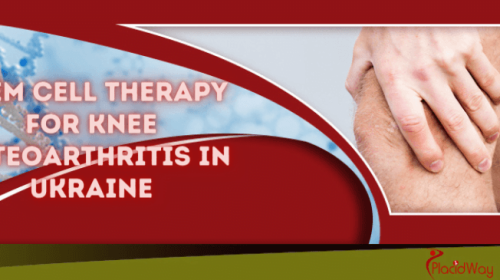Navigating the Future of Osteoarthritis Treatment with Stem Cell Therapy
Osteoarthritis is a common degenerative joint disease that affects millions of people worldwide. It is the most prevalent form of arthritis and is characterized by the breakdown of cartilage in the joints, leading to pain, stiffness, and reduced mobility.
The exact cause of osteoarthritis is not fully understood, but several factors contribute to its development. Age is a significant factor, as osteoarthritis becomes more common with advancing age. Genetic factors can also influence the development of osteoarthritis, and certain joint abnormalities present from birth can increase the risk. Joint injuries or repetitive stress on a joint are also known to contribute to osteoarthritis, and excessive weight, such as in obesity, puts additional stress on joints, especially the knees and hips.
The symptoms of osteoarthritis typically develop gradually and worsen over time. Joint pain is a common symptom, which usually worsens with activity and improves with rest. Stiffness in the affected joint is also experienced, especially after periods of inactivity or rest. Swelling and tenderness may occur around the affected joint, making it difficult to move the joint fully. In some cases, bone spurs may form around the affected joint, and a grating or cracking sound may be felt or heard during joint movement.

Stem Cell Treatment for Osteoarthritis
Stem cell treatment for osteoarthritis is an emerging area of research and potential therapy. Stem cells are undifferentiated cells that have the ability to differentiate into various cell types in the body. They also possess the potential to promote tissue repair and regeneration.
In the context of osteoarthritis, the goal of stem cell treatment is to stimulate the repair and regeneration of damaged cartilage in the affected joints. Several types of stem cells have been investigated for their potential in treating osteoarthritis, including mesenchymal stem cells (MSCs) derived from various sources such as bone marrow, adipose tissue (fat), and umbilical cord tissue.
The potential benefits of stem cell treatment for osteoarthritis include:
- Cartilage regeneration: Stem cells have the potential to differentiate into chondrocytes, which are the cells that produce cartilage. By introducing stem cells into the damaged joint, there is a possibility of promoting the regeneration of new cartilage.
- Anti-inflammatory effects: Stem cells also possess anti-inflammatory properties that can help reduce inflammation in the joint, which is a common feature of osteoarthritis.
- Tissue repair and remodeling: Stem cells may release various growth factors and signaling molecules that promote tissue repair and remodeling, potentially improving the overall condition of the joint.
Procedure of Stem Cell Therapy for Osteoarthritis
Patient Evaluation
The first step involves a comprehensive assessment of the patient by a qualified healthcare professional. The physician will review the patient’s medical history, conduct physical examinations, and potentially order additional diagnostic tests (like X-Rays or MRIs) to determine the severity of the osteoarthritis and to decide whether stem cell therapy is an appropriate treatment option.
Stem Cell Harvesting
If the patient is deemed a good candidate for stem cell therapy, the next step is to collect the stem cells. This typically involves harvesting stem cells from the patient’s own body – usually from the bone marrow or adipose (fat) tissue. This is usually done using a needle and syringe under local anesthesia.
Stem Cell Processing
The collected cells are then processed, often in a lab. This typically involves centrifugation, which separates the stem cells from other components of the collected tissue. In some procedures, the stem cells may be multiplied in a lab to increase their numbers before they are reintroduced into the patient’s body.
Preparing the Injection
While the stem cells are being processed, the area of the patient’s body that will receive the stem cell injection is prepared. This might involve cleaning and disinfecting the skin, and potentially administering local anesthetic to minimize discomfort during the injection.
Stem Cell Injection
Once the stem cells are ready and the injection site has been prepared, the stem cells are injected into the affected joint using a syringe. This is often guided by imaging technology like ultrasound or fluoroscopy to ensure the cells are delivered to the exact location where they are needed.
Post-Treatment Care
Following the procedure, the patient’s progress is monitored by the healthcare team. This typically involves follow-up visits to assess how the patient’s body is responding to the treatment and to monitor for potential side effects. Physical therapy or other rehabilitation protocols may be recommended to support healing and joint function.
Best Hospitals for Osteoarthritis in the World
America, Bogota, Colombia
America, Guadalajara, Mexico
Mexico, America, Nuevo Progresso
America, Guadalajara, Mexico
Regenerative Medicine Packages for Osteoarthritis
Stem Cell Therapy for Knees Success Stories
Are you tired of living with the constant pain and limited mobility caused by osteoarthritis? Don’t let osteoarthritis control your life any longer. Join the thousands of satisfied patients who have already experienced the remarkable benefits of stem cell therapy for osteoarthritis. Take charge of your health and embrace the possibilities that stem cell therapy offers. Contact us to start your journey toward a pain-free future!
Frequently Asked Questions
How is osteoarthritis diagnosed?
Diagnosing osteoarthritis typically involves a combination of medical history assessment, physical examination, imaging tests (such as X-rays or MRI), and possibly joint fluid analysis to rule out other possible causes of joint pain.
Can Osteoarthritis be cured?
Currently, there is no known cure for osteoarthritis. However, with appropriate treatment and management strategies, it is possible to effectively control symptoms, slow down the progression of the disease, and improve overall joint function.
How does exercise benefit Osteoarthritis?
Exercise plays a crucial role in managing osteoarthritis. It helps improve joint flexibility, strengthen muscles around the affected joints, and maintain a healthy weight. Low-impact exercises like walking, swimming, cycling, and gentle stretching can be beneficial. However, it’s important to consult with a healthcare professional or physical therapist to determine the most suitable exercise program for your specific condition.
Can Osteoarthritis affect other parts of the body besides joints?
While osteoarthritis primarily affects joints, it can sometimes lead to complications or symptoms in other areas. For example, osteoarthritis in the knees can cause changes in gait, leading to hip or back pain. It can also affect the hands and finger joints, resulting in difficulty gripping or performing fine motor tasks.
What is the success rate of stem cell treatment for Osteoarthritis?
The success rate of stem cell treatment for osteoarthritis can vary depending on various factors, including the severity of the condition, the patient’s overall health, the specific treatment protocol used, and individual variations in response to the therapy. It’s important to note that while there is promising evidence suggesting the potential benefits of stem cell therapy for osteoarthritis, more extensive clinical research is needed to establish the definitive success rate.
Request Free Quote














